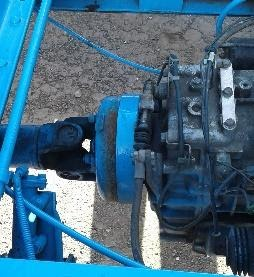 You may have seen some of the recent publicity about Cardan Shaft Park Brakes, in the form of safety alerts from both Worksafe and the Transport Agency and wondered what it is all about.
You may have seen some of the recent publicity about Cardan Shaft Park Brakes, in the form of safety alerts from both Worksafe and the Transport Agency and wondered what it is all about.
As you can see from the photo a Cardan Shaft Park Brake (CSB), also known as a transmission or driveshaft brake, is a brake mounted on the end of the gearbox between the gearbox and the drive shaft. It does not act directly on the wheels but, when applied, stops the drive shaft from turning and acts as a brake on the wheels through the diff. A CSB is cable operated from the park brake lever and can be either a disc or drum brake but most commonly drum.
Recently the Transport Agency carried out a roadside testing programme with the CVST at their Paremata weigh station. Ninety vehicles equipped with CSB were randomly chosen and tested over a couple of weeks. After being subjected to a stall test as required by CoF to confirm that they met the minimum standard required by the Agency each vehicle had its park brake applied and a pull load was applied through a load cell to check that the vehicles met what was the equivalent of being fully laden on a 1 in 5 (20%) slope. This test was completed in both directions. Drivers were also questioned about their knowledge and understanding of CSB and their understanding of the advantages and limitations of the system and a brief summary of results is shown here;
- 2/3 of drivers were unaware of the type of park brake fitted to the vehicle they were driving
- Over 2/3 of drivers had no knowledge or understanding of CSB
- 2/3 of drivers were unaware that CSB should not be applied when the vehicle is moving
- Almost 80% of drivers were unaware of when the most recent park brake servicing occurred
- Over 70% of drivers had had park brake issues, including roll-aways, with the vehicles they were driving
- Almost 8% of vehicles could not be effectively stall tested as they had automatic or automated manual transmissions.
- Of the remainder 86% passed the stall test
- 72% of vehicles passed the pull test in the forward direction [downhill] although one vehicle was so lightly loaded it started to skid.
- 79% of vehicles passed the pull test in the rearward direction [uphill]
- Only 2/3 of vehicles held in both directions
While a properly maintained to the manufacturers’ specifications, a CSB is designed to hold the parked vehicle stationary if used correctly, this type of brake, in service, reacts differently to brakes that act directly on the wheels and the following precautions should be followed;
-
- A CSB is a park brake – not a hand brake.
- Don’t use a CSB park brake for stopping. These brakes are not designed to be part of the foundation braking system and, if used while the vehicle is moving, can damage the driveline, the brake or both.
- A CSB is not an Emergency Brake. If the CSB park brake is used as an emergency brake it can result in catastrophic failure of the driveline and subsequent loss of control.
- The park brake must be fully released before moving away from a stop. Engine power will quickly overcome a partially applied park brake and it will wear out making it ineffective for later use.
- These brakes are very sensitive to changes in load and the brake should be fully applied before adding load even if this requires more than the normal pull you would expect to apply to the park brake.
- When parking on a slope always ensure the front wheels are turned into the kerb if facing downhill or away from the kerb if facing uphill so, in the event of a runaway, the vehicle will run into the kerb.
- Ensure the vehicle is left in first or reverse (depending on direction) or, if an automatic or automated manual, in park.
- Chocks must be sized correctly to be effective
- Use of chocks may mask a faulty or poorly applied park brake and should not be removed unless someone is in the driver’s seat with the service brake applied, especially when being used on a slope.
- Care must be taken when parking in an area where the rear wheels will be on dissimilar surfaces such as where one side of the vehicle is on grass or gravel while the other is on the road as if one wheel starts to skid the other will rotate allowing the vehicle to run away. This is due to the fact that the park brake does not act directly on the wheels and the differential allows the wheels to rotate independently.
- If you have to jack up the rear axle you must use chocks as the park brake will no longer be effective as soon as one wheel loses contact with the ground.
- Similarly if, in the event of a breakdown, the diff head, an axle or the driveshaft is removed to allow the vehicle to be towed, then the CSB is no longer effective.
- If you are towing any trailer it must have its own independent park brake. The CSB on the towing vehicle is not designed to support the unbraked weight of a laden trailer when parked
